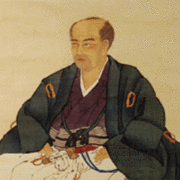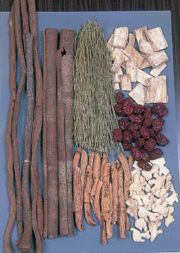Category:CD
m (→{{Bilingual|漢方|Kampo Medicine}}) |
m |
||
| Line 7: | Line 7: | ||
=={{Bilingual|漢方|Kampo Medicine}}== | =={{Bilingual|漢方|Kampo Medicine}}== | ||
| − | ==={{Bilingual| | + | ==={{Bilingual|漢方 ≠ Chinese Medicine|Kampo ≠ Chinese Medicine}}=== |
{| | {| | ||
| | | | ||
| Line 25: | Line 25: | ||
|} | |} | ||
| − | ==={{Bilingual| | + | ==={{Bilingual|イギリス医薬やドイツ医薬とは言わないのに、なぜ漢方か|Why do we care Chinese or Japanese when do not care for English or German medicine?}}=== |
{| | {| | ||
| | | | ||
| Line 44: | Line 44: | ||
| | | | ||
[[Image:HanaokaSeishu.gif|thumb|{{Bilingual|華岡青洲 彼が考案し現在も処方されるものに[[Kampo:Shiunko|紫雲膏]]、[[Kampo:Chuoko|中黄膏]]、[[Kampo:Jumihaidokuto|十味排毒湯]]。画像はWikipedia。|Some of his recipes are still officially approved and used: [[Kampo:Shiunko|Shiunko]], [[Kampo:Chuoko|Chuoko]], and [[Kampo:Jumihaidokuto|Jumihaidokuto]]. Picture is from Wikipedia.}}]] | [[Image:HanaokaSeishu.gif|thumb|{{Bilingual|華岡青洲 彼が考案し現在も処方されるものに[[Kampo:Shiunko|紫雲膏]]、[[Kampo:Chuoko|中黄膏]]、[[Kampo:Jumihaidokuto|十味排毒湯]]。画像はWikipedia。|Some of his recipes are still officially approved and used: [[Kampo:Shiunko|Shiunko]], [[Kampo:Chuoko|Chuoko]], and [[Kampo:Jumihaidokuto|Jumihaidokuto]]. Picture is from Wikipedia.}}]] | ||
| + | |||
| + | [[Image:Kakkonto.jpg|thumb|{{Bilingual|葛根湯のレシピ ([[Kampo:Kakkonto|詳細]])|Recipe for "Kakkonto", or pueralia root decoction ([[Kampo:Kakkonto|''More'']])}}]] | ||
|} | |} | ||
| Line 57: | Line 59: | ||
}} | }} | ||
| − | + | =={{Bilingual|漢方の標準 <small>(一般用漢方製剤承認基準)</small>|Kampo Standards}}== | |
| − | {{ | + | ==={{Bilingual|漢方処方の新基準|The New Standards for Kampo Formulas}}=== |
| − | + | ||
| − | + | ||
| − | + | ||
| − | + | ||
| − | }} | + | |
| − | |||
| − | |||
| − | |||
{{Twocolumn| | {{Twocolumn| | ||
| − | |||
In early 1970, the Ministry of Health and Welfare (now [http://www.mhlw.go.jp/English Health, Labor and Welfare]) summarized the byelaw published as "Guideline for General Kampo Formulas" (Edited by MHW and the committee in [http://www.fpmaj.gr.jp/ FPMAJ], Published by Jiho), which has been known as 'The 210 formulas' for 30 years. In 2008, it underwent a significant revision and 213 formulas are listed as "Standards of Approval for the Kampo Formulation". The difference is introduced [[Doc:薬局方新基準|here]] (in Japanese). | In early 1970, the Ministry of Health and Welfare (now [http://www.mhlw.go.jp/English Health, Labor and Welfare]) summarized the byelaw published as "Guideline for General Kampo Formulas" (Edited by MHW and the committee in [http://www.fpmaj.gr.jp/ FPMAJ], Published by Jiho), which has been known as 'The 210 formulas' for 30 years. In 2008, it underwent a significant revision and 213 formulas are listed as "Standards of Approval for the Kampo Formulation". The difference is introduced [[Doc:薬局方新基準|here]] (in Japanese). | ||
| | | | ||
| − | |||
1970年代初頭に厚生省(現[http://www.mhlw.go.jp/ 厚生労働省])が定めた内規は「一般用漢方処方の手引き」(厚生省薬務局監修、[http://www.fpmaj.gr.jp/ 日本製薬団体連合会]漢方専門委員会編、薬業時報社発行)という書籍に掲載され、「210処方」の名称でおよそ30年間流通しました。平成20年に大幅な見直しが行われ、「一般用漢方製剤承認基準」として213処方が定められました。 | 1970年代初頭に厚生省(現[http://www.mhlw.go.jp/ 厚生労働省])が定めた内規は「一般用漢方処方の手引き」(厚生省薬務局監修、[http://www.fpmaj.gr.jp/ 日本製薬団体連合会]漢方専門委員会編、薬業時報社発行)という書籍に掲載され、「210処方」の名称でおよそ30年間流通しました。平成20年に大幅な見直しが行われ、「一般用漢方製剤承認基準」として213処方が定められました。 | ||
| − | |||
| − | |||
}} | }} | ||
| − | |||
| − | |||
| − | |||
| − | |||
| − | =={{Bilingual|日本薬局方|Japanese Pharmacopoeia | + | ==={{Bilingual|日本薬局方|Japanese Pharmacopoeia}}=== |
| − | + | ||
{{Twocolumn| | {{Twocolumn| | ||
(Japanese) Pharmacopoeia is a book with legal force containing directions to identify and qualify medicinal compounds that may be used in Japan. | (Japanese) Pharmacopoeia is a book with legal force containing directions to identify and qualify medicinal compounds that may be used in Japan. | ||
| Line 94: | Line 79: | ||
}} | }} | ||
| − | + | ;Details (only in Japanese) | |
| − | ; | + | {{GenerateIndex|Doc|薬局方新基準}} |
| − | + | ||
| − | + | =={{Bilingual|このサイトについて|about this site}}== | |
| + | ==={{Bilingual|生薬情報|Crude Drug Information}}=== | ||
| + | {{Twocolumn| | ||
| + | In the Japanese Pharmacopoeia, around 160 crude drugs are listed. This site introduces [[Persist:CrudeDrugList|their details]] with links to available [[Persist:KampoList|Kampo formulas]]. | ||
| | | | ||
| − | + | 本サイトは日本薬局方に掲載されるおよそ[[Persist:CrudeDrugList|160の生薬]]に加え、各生薬について利用される[[Persist:KampoList|漢方処方]]等の詳細を紹介しています。 | |
| − | + | ||
| − | + | ||
| − | + | ||
| − | + | ||
}} | }} | ||
| − | =={{Bilingual|文献情報|Literature Information}}== | + | ==={{Bilingual|文献情報|Literature Information}}=== |
{{Twocolumn| | {{Twocolumn| | ||
This site contains {{#countTitle:_*|KampoReference}} article information on Kampo formulas. They are listed at the bottom of each page for Kampo prescription. | This site contains {{#countTitle:_*|KampoReference}} article information on Kampo formulas. They are listed at the bottom of each page for Kampo prescription. | ||
| Line 115: | Line 98: | ||
}} | }} | ||
| − | =={{Bilingual|市場流通品、理化学試験、生産情報|Availability, Production Methods, Examinations}}== | + | ==={{Bilingual|市場流通品、理化学試験、生産情報|Availability, Production Methods, Examinations}}=== |
* By [[Index:Tochimoto| {{#ifeq:{{#var:LANG}}|ja|栃本天海堂|Tochimoto Tenkaido Co. Ltd.}}]] | * By [[Index:Tochimoto| {{#ifeq:{{#var:LANG}}|ja|栃本天海堂|Tochimoto Tenkaido Co. Ltd.}}]] | ||
| − | =={{Bilingual| | + | ==={{Bilingual|画像ギャラリー|Image Gallery}}=== |
* By [[Index:Alps-Pharm| {{#ifeq:{{#var:LANG}}|ja|アルプス薬品工業|Alps Pharmaceutical Industry Co. Ltd.}}]] | * By [[Index:Alps-Pharm| {{#ifeq:{{#var:LANG}}|ja|アルプス薬品工業|Alps Pharmaceutical Industry Co. Ltd.}}]] | ||
* By [[Index:NTS| {{#ifeq:{{#var:LANG}}|ja|株式会社エヌ・ティー・エス|NTS Book Inc.}}]] | * By [[Index:NTS| {{#ifeq:{{#var:LANG}}|ja|株式会社エヌ・ティー・エス|NTS Book Inc.}}]] | ||
| + | |||
| + | |||
| + | ==={{Bilingual|学会情報|Society Information}}=== | ||
| + | {{Twocolumn| | ||
| + | * [http://www.kaim.us/special_TOC.html Special Issue ''Current Kampo Medicine''] | ||
| + | | | ||
| + | * [http://www.jsom.or.jp/html/index.htm 日本東洋医学会] | ||
| + | * [http://www.wakan-iyaku.gr.jp/index2.html 和漢医薬学会] | ||
| + | }} | ||
Revision as of 11:28, 18 August 2011
Kampo/Crude Drug Wiki (漢方・生薬Wiki)
Contents |
M e n u
| Crude-drug Top Gallery |
General Index | Names | Prescriptions | Books | Journals | Terminology | Chinese Medicines |
Kampo Medicine
Kampo ≠ Chinese Medicine
|
In the WHO document, Kampo is defined as "the medicine traditionally practiced in Japan, based on ancient Chinese medicine". We might call it "the traditional Japanese medicine" but this expression should include acupuncture and moxibustion treatment and is a larger concept than Kampo. |
 Portable Medicine Cabinet (Edo era; 1862) Reproduced with permission from Naito Museum of Pharmaceutical Science and Industry |
Why do we care Chinese or Japanese when do not care for English or German medicine?
|
Why are we sensitive to either Japanese or Chinese?
Western medicine is based on chemical structures, and each structure is (or was) patented. In this sense, their origin is clear. On the other hand, traditional (especially herbal) medicine is one major intellectual-property issue related to biological diversity. It is therefore important to clarify origins and install an appropriate international standard. |
 Some of his recipes are still officially approved and used: Shiunko, Chuoko, and Jumihaidokuto. Picture is from Wikipedia.  Recipe for "Kakkonto", or pueralia root decoction (More) |
- Summary (more)
- Kampo Medicine
Mixed recipes of crude drugs in Japanese distinct style, originally based on classic literature such as "Shokanron" and "Kinkiyoryaku" from ancient China. - Traditional Chinese Medicine (TCM)
Mixed recipes of crude drugs in China. It is more flexible depending on patients' conditions and uses hundreds of raw materials from plants as well as animal origins. - Folk Medicine
Usually single crude drugs used by tradition or hunch.
Kampo Standards
The New Standards for Kampo Formulas
In early 1970, the Ministry of Health and Welfare (now Health, Labor and Welfare) summarized the byelaw published as "Guideline for General Kampo Formulas" (Edited by MHW and the committee in FPMAJ, Published by Jiho), which has been known as 'The 210 formulas' for 30 years. In 2008, it underwent a significant revision and 213 formulas are listed as "Standards of Approval for the Kampo Formulation". The difference is introduced here (in Japanese).
Japanese Pharmacopoeia
(Japanese) Pharmacopoeia is a book with legal force containing directions to identify and qualify medicinal compounds that may be used in Japan. Its revision process therefore requires utmost attention. Since it is a legal document, there are some side effects such as for the scientific name of Cinnamon.
- Details (only in Japanese)
about this site
Crude Drug Information
In the Japanese Pharmacopoeia, around 160 crude drugs are listed. This site introduces their details with links to available Kampo formulas.
Literature Information
This site contains 7677 article information on Kampo formulas. They are listed at the bottom of each page for Kampo prescription.
Availability, Production Methods, Examinations
Image Gallery
Society Information
Pages in category "CD"
The following 8 pages are in this category, out of 8 total.